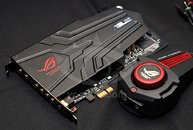- Joined
- Oct 9, 2007
- Messages
- 47,636 (7.44/day)
- Location
- Dublin, Ireland
| System Name | RBMK-1000 |
|---|---|
| Processor | AMD Ryzen 7 5700G |
| Motherboard | Gigabyte B550 AORUS Elite V2 |
| Cooling | DeepCool Gammax L240 V2 |
| Memory | 2x 16GB DDR4-3200 |
| Video Card(s) | Galax RTX 4070 Ti EX |
| Storage | Samsung 990 1TB |
| Display(s) | BenQ 1440p 60 Hz 27-inch |
| Case | Corsair Carbide 100R |
| Audio Device(s) | ASUS SupremeFX S1220A |
| Power Supply | Cooler Master MWE Gold 650W |
| Mouse | ASUS ROG Strix Impact |
| Keyboard | Gamdias Hermes E2 |
| Software | Windows 11 Pro |
ASUS displayed its latest sound card, the Republic of Gamers (ROG) Phoebus. This card is designed for multichannel gaming audio. While it might not pack any fancy DSP that doesn't already exist, its AMP circuitry is so designed to give the best positional audio that could come handy with competitive online gaming. With this card, ASUS also brought to the fore C-Media's latest audio chipset, the CMI 8788DH Oxygen Express, which packs native PCI Express support. All PCI Express sound cards launched by ASUS so far feature OxygenHD and ASUS-rebadged AV-100 chipsets, that use legacy PCI, and hence depend on PCIe-to-PCI bridge chips by PLX to function on PCI Express.
The primary DAC for headphone/front-out channel of the ROG Phoebus is TI-BB PCM1792A, with stellar signal-noise ratio (SNR) of 127 dBA. Other main channels are handled by Cirrus Logic, probably the CS5381, with SNR of 120 dBA. There's also a tertiary Realtek ALC889 (110 dBA) CODEC that probably handles an independent set of audio channels, or handles the digital outputs, since it's licensed with a few Dolby technologies. On the AMP side, we spy bleeding-edge OPAMPs, a Texas Instruments 6120A2(?) AMP chip (for the headphones channel), etc.





Many parts of the card are electrically isolated from the PCI Express slot, to prevent interference from the ground layer of the motherboard. So these parts rely on power drawn from a 6-pin PCIe power connector, conditioned by a tiny VRM. Only the power-conditioning parts of the card use solid-state capacitors, the AMP and audio parts use audiophile-grade electrolytic capacitors since by design they are better for analogue circuits. The whole card is topped off with a groovy-looking EMI shield. Expect this card to be costly.
View at TechPowerUp Main Site
The primary DAC for headphone/front-out channel of the ROG Phoebus is TI-BB PCM1792A, with stellar signal-noise ratio (SNR) of 127 dBA. Other main channels are handled by Cirrus Logic, probably the CS5381, with SNR of 120 dBA. There's also a tertiary Realtek ALC889 (110 dBA) CODEC that probably handles an independent set of audio channels, or handles the digital outputs, since it's licensed with a few Dolby technologies. On the AMP side, we spy bleeding-edge OPAMPs, a Texas Instruments 6120A2(?) AMP chip (for the headphones channel), etc.





Many parts of the card are electrically isolated from the PCI Express slot, to prevent interference from the ground layer of the motherboard. So these parts rely on power drawn from a 6-pin PCIe power connector, conditioned by a tiny VRM. Only the power-conditioning parts of the card use solid-state capacitors, the AMP and audio parts use audiophile-grade electrolytic capacitors since by design they are better for analogue circuits. The whole card is topped off with a groovy-looking EMI shield. Expect this card to be costly.
View at TechPowerUp Main Site









